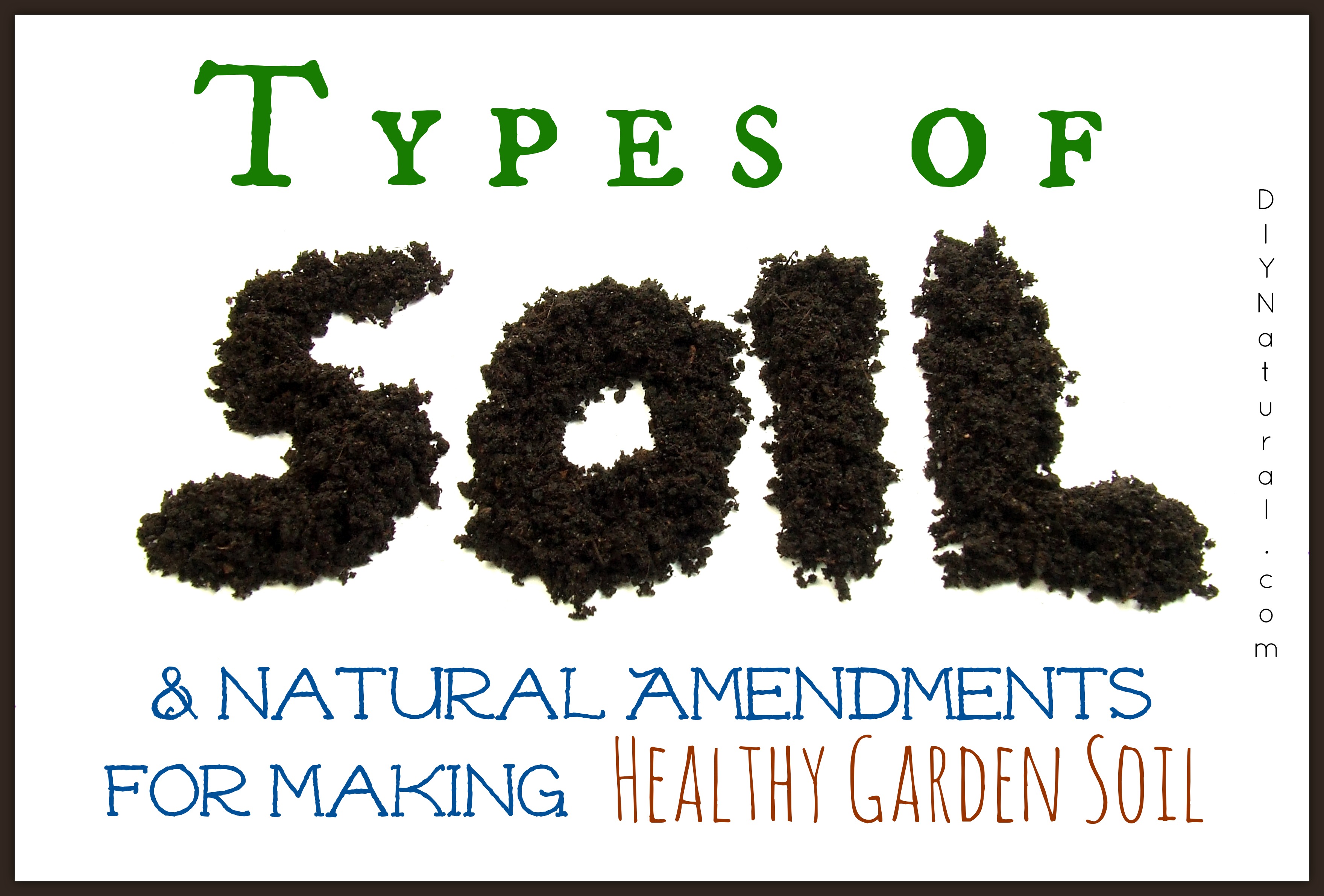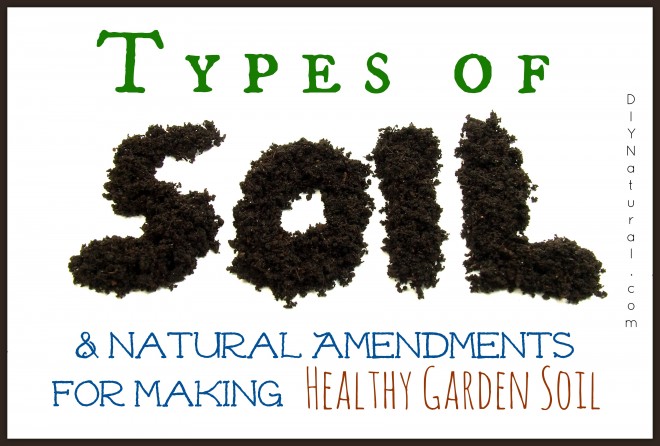During the winter I like to get a jump on my gardens by working the soil and fixing any problems that may have occurred over the planting season. In order to fix problems, you’ll first need to know what soil type you’re working with – there are three main types.
What makes these types of soil what they are and how do we fix them naturally if they aren’t what we need? Read on!
Soil Types
The three main types of soil are sand, silt and clay. Loam is a combination of all of these.
All soil is made up of rock particles in different sizes along with organic matter and possibly other things. Rock is usually large, such as gravel. In smaller pieces, it is known as sand. Go even smaller and you have silt and finally, very tiny pieces are known as clay.
Natural Fixes for Problem Soils
Gravel
I’ve included gravel as a fourth soil type as this is where most all soil comes from. Planting can be done in gravel, but it lacks the smaller structure that plant roots prefer. You can add some clay and organic matter to gravel, but many times the pieces are just too large. Remove any rocks that are more than two inches in size for optimum root production. Winter may help facilitate breaking up of gravel with freeze/crack. This is when ice melts in the winter causing water runoff. Some of this water is trapped in the rock, refreezing at night. The expansion from the resulting ice causes the rock to crack.
Sand
Sand may seem easier to work with because it drains well, but it’s trickier than you might think. Sand particles are larger and do facilitate drainage, but when totally saturated, they form dense mats of water. Much of Florida is sand and I’ve seen the results of too much water. The sand fills up and when totally saturated, it forms what’s known as “sheet flow.” This is when a large amount of water in sand moves on it’s own. For crops, it can be very bad, taking much needed organic matter with it.
This problem can be alleviated by adding some organic matter to the soil and working it in. This will help hold the moisture where it is.
Silt
Silt is finer than sand and often contains organic matter. Because of its smaller size, it holds onto organic matter better than sand or clay. This is the most desirable of all of the soil types for crop production.
Clay
Clay is very fine particles of rock that usually never drains and can become very acidic. You need to add a lot of organic matter to the soil in order for it to be usable for most plants. Some, however, thrive in this type of environment. Rhododendrons, laurels and azaleas all do very well in the acidic clay soils in my area (Western North Carolina), along with blueberries. They love a pH of 4.5 to 6.5. In other parts of the country, you may need to adjust your pH for these crops.
Organic Matter
I’ve mentioned organic matter several times now and some of you may be wondering what it is. Organic matter is any plant material that you can use to improve your garden and benefit your plants.
Compost
Compost can be made at any time by anyone. It can be as simple as keeping your kitchen scraps in a bucket and letting them decompose, or as complicated as a three station compost bin.
In the case of a three station compost bin, you would add all your materials to the first bin the first year. In year two, you would leave bin one alone and add all your kitchen/yard scraps to bin two. Then in year three, you leave bin two alone, add your materials to bin three and start using the rich compost created in bin one. There are other ways to0 make compost, such as the quick method described here.
Mulch
Other organic matter can be in the form of mulch. One of my favorites is pine bark mulch. It has just the right pH for acidic soils, allows drainage while retaining moisture and is inexpensive. You can get it at most any garden supply store.
Don’t get pine bark nuggets – it’ll be years before they are of any benefit to you. And don’t use pine sawdust unless it’s well rotted. Fresh pine sawdust will take every bit of nitrogen out of the ground. If you must use it, be sure to compensate for the loss of nitrogen.
Cover crops
Another way to add organic matter is to plant cover crops (aka “green manure”). A cover crop is a crop that is planted just for tilling back into the soil therefore adding vital nutrients. Clover, buckwheat and fava beans have been used successfully. These have the added benefit of adding much needed nitrogen to the soil.
Biochar
Finally, in the wood category is biochar. Biochar is charred wood that holds onto nutrients in the soil and keeps it usable for many years. It’s been used since the time of the Incas and Mayans of Central and South America and those soils they improved at that time are still viable to this day. You can read more about biochar here.
No matter what your soil type, there is always a way to fix it, even if your solution is raised garden beds. Get a soil test done today (many county extension services offer it free) and find out your soil type.
Have you used any of these natural solutions for soil problems? What worked for you?
*******





I live in Western CO where the soil is alkaline clay it will turn white on top when its dried out. Help!! = )
Hi Kat, there are many things you can do to help the soil. One of the big ones is to work in some pine bark mulch. It will add organic matter to the soil and help to lower the pH. It will help to break up clay soil, retaining moisture in a good way while providing aeration. Pine needles can also be worked in, but they take a while to break down. You can add garden sulfur to the soil to make it more acidic. Organic matter is the best choice here, working in as much as you can at one time, then a few weeks later, go back and do it again. It’ll be a lot of work, bit it’ll be well worth it.
We have gardened in the beautiful rich loam of Nebraska for 35 years–but were transferred to Eastern NC 3 months ago. Of course one of the first priorities was getting a garden spot. I went to the County Extension office and talked to the person who supervises agriculture. She had a wealth of printed and verbal information. She gave me the information and boxes to have our soil tested at the State. For free to a small charge they will test the soil and give you recommendations for what needs to be added. They ask your location, and what you want to grow. Our soil is very sandy as we are close to the coast. She had told me that our soil was very acidic and would need lime added–which would take at least 6 months to work its magic. Our soil test came back yesterday at 5.5–perfect for the huge planting of azaleas in front of our house–but not optimal for the vegetables and flowers that I love. She also told us to make sure we composted the leaves from the many oak trees as they contain tannin that prevents seeds from sprouting. We had already tilled in one layer of leaves–and purchased a composted to work the house compost more effectively. Is there an effective method of getting lime into the soil with cover crops? I believe that lime is a naturally occurring product–so would that be natural? I really want to be planting potatoes NOW–but know I need to wait until the soil will produce. I hate wasting expensive seeds on soil that won’t grow.
Hi Cheryl, You could try fast acting lime, but it might still take a while. I’m glad they told you it would take 6 months to be of any use. Most people think it works right away. You can use the oak leaves if you compost them first and turn them into soil. Once they are shredded, they break down faster and a lot of the tannins are released. For the veggies and flowers, 5.5 is on the low end of the acidic scale, so bringing it up just a bit will help a lot. Tomatoes and peppers do best at 5.5 to 6.5, so you really don’t need much. You can do raised beds and solve part of the problem.
Thanks so much for this timely post. We are finally getting a break from the extreme winter here in Kentucky and I’m excited to get out and “play” in my dirt! I will be thinking about ways to incorporate all the ideas presented into my garden planning.
Debra, Where are you in North Carolina? When I read your location above, I just had to ask. We are in Murphy, NC 28906. Moving here from a city near Raleigh, NC is a great change for the better! Thanks for all of your wonderful ideas…we use so many of them. -Lynne
Thanks Lynne! We are about 10 miles east of Asheville just off of I40. I’ve visited Murphy and I believe the soil there is similar-clay and rocks. And thanks for the kind words!